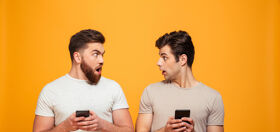
Thirty years ago, queer filmmaker Gregg Araki unveiled his fourth feature, Totally F***ed Up, at the Sundance Film Festival.
Rebellious, independent, and fearlessly queer, Araki’s radical spin on the coming-of-age genre would later be recognized as the first of his “Teenage Apocalypse” trilogy, which also included the dark road-trip romance The Doom Generation (’95) and sci-fi-twinged black comedy Nowhere (’97).
Nearly three decades on, one might expect these films to feel tame in retrospect, that maybe they—like many thirty-somethings—have lost some of their edge.
But that’s the thing about Araki: No matter how much the world changes (or does’t), his oeuvre is always on the bleeding edge—sexy, funny, shocking, punk, and unabashedly queer.
Timelessly transgressive, Araki is, without a doubt, one of the most important directors to come out of the ’90s, whose influential work will surely continue to inspire the independent filmmaking landscape for another 30 years, at least!
Born in 1959 to Japanese-American parents just outside of Los Angeles, Araki has said he came of age at “such an innocent time.” That made him all the more susceptible to the influence of punk rock, new wave, and the indie alternative culture that began to bubble up in the early ’80s, just as he was beginning film school.
After attending UC Santa Barbara, he enrolled in University Of Southern California’s School Of Cinematic Arts, and graduated with an M.F.A. in ’85. From then it wasn’t long until he got to work, creating films independently with practically non-existent budgets.
His first was Three Bewildered People In The Night, shot guerilla-style in black-and-white on a stationary camera, telling the story of—you guessed it—three people, one of which was gay. Then came the equally DIY, The Long Weekend (O’ Despair), in ’89, following one weekend in the lives of three couples, also including queer characters.
But it was his third feature, The Living End, that signified his major breakthrough into a still-nascent indie film scene after it premiered at the Sundance Film Festival in ’92. Described as a “gay Thelma & Louise,” it followed two young outlaws, bonding over their shared HIV status as they embark on a roadtrip with a shared motto leading the way: “F*ck everything!”
Boldly sexual, dangerous, and liberated—and made for only $20,000 (pennies by today’s moviemaking standards)—the film became Araki’s calling card, firmly cementing the director as one of the leading voices of the New Queer Cinema movement, which saw a surge of LGBTQ+ storytellers bring their voices to the movie screen.
Related:
Queer director Gregg Araki remembers the sex scene that shocked and angered audiences, 30 years on
“When it screened at Sundance, I remember people were just so outraged.”
In the early ’90s, even the mere sight of two men kissing shocked audiences, but The Living End still remains shocking today in its anarchic sensibility and frank discussion of AIDS. Reflecting on the film with i-D, Araki said it feels “almost like a journal” to him,”capturing the spirit of queer youth and a reckless abandon during another dark moment in gay history.”
Araki was on a hot streak throughout the ensuing decade, delivering his signature Teenage Apocalypse trilogy, the polysexual rom-com Splendor in ’99 (inspired by his own relationship with actress Kathleen Robertson), and the stirring coming-of-age drama, Mysterious Skin in ’04. The latter, which stars a young Joseph Gordon-Levitt in his breakout role, tells the story of two teens coping with sexual abuse in the American suburbs. While at times a tough watch, it’s been lauded for its candid approach to a taboo subject.
In 2007, he shifted gears with the Anna Faris-lead stoner comedy Smiley Face, and then returned to his forte—horny, beautiful, young people in despair—in ’10 with Kaboom, which premiered at the Cannes Film Festival and became the first-ever Queer Palm award winner, designated to honoring features addressing LGBTQ+ themes.
Related:
“Excruciatingly hot” roommates, a masked madman & more from the Cannes canon to stream this weekend
Welcome to your weekend streaming recommendations, a.k.a. the Weekend Watch, a handy guide to the queerest film and TV content that’s just a click away!
While it’s been nearly a decade since his last feature, White Bird In A Blizzard, Araki has remained active as a television director, helming episodes of 13 Reasons Why, American Crime, Riverdale, and the short-lived (and under-appreciated) Heathers.
In 2019, he even created his own series for Starz, Now Apocalypse, which featured many of his signatures: Beautiful people (hello, Avan Jogia!), sex, love, the pursuit of fame—oh, and lizard-like aliens who are trying to take over the world, or maybe they’re just drug-fueled hallucinations.
Though we’re eagerly awaiting the next time Araki brings one of his own stories to the screen (he told i-D last year, “I have a few things I’m working on—some exciting, very surprising”), the milestone anniversary of the Teenage Apocalypse trilogy gives us the perfect excuse to look back at and honor his culture-shifting body of work, which paved daring new paths for queer voices at the movies.
The world of queer cinema—and the world itself—would be a much more boring place without Gregg Araki.
Here’s where you can stream the films of Gregg Araki this Pride Month
- Three Bewildered People In The Night (1987): Viewable on YouTube.
- The Long Weekend (O’ Despair) (1989): Not currently available online.
- The Living End (1992): Streaming on Kanopy; available for digital rental via AppleTV, Prime Video, Google Play, and YouTube TV.
- Totally F***ed Up (1993): Streaming on The Criterion Channel and Kanopy.
- The Doom Generation (1995): Streaming on The Criterion Channel. Plus, brand-new 4K restoration is hitting select theaters throughout the summer via Strand Releasing—more details here.
- Nowhere (1997): Viewable via the Internet Archive.
- Splendor (1999): Viewable via the Internet Archive.
- Mysterious Skin (2004): Streaming on The Criterion Channel. Available for digital rental via AppleTV, Prime Video, Google Play, and YouTubeTV.
- Smiley Face (2007): Streaming on Tubi, Vudu, and Freevee. Available for digital rental via Prime Video.
- Kaboom (2010): Streaming on Tubi, Kanopy, Plex, and AMC+. Available for digital rental via AppleTV, Prime Video.
- White Bird In A Blizzard (2014): Streaming on Max, Kanopy, and FuboTV. Available for digital rental via AppleTV, Prime Video, Google Play, and YouTube TV.
- Now Apocalypse (2019): The entire series is streaming via Prime Video, The Roku Channel, and the Starz app. Available for digital rental via AppleTV, Prime Video, and Vudu.
Related:
Gregg Araki on his Starz series ‘Now Apocalypse’: “So now they go to a sex party…”
Aliens, hookups, casting couches, Trumpism and rocket science: the creators spill on their new series.


























